A Parametric-Simulation Method to Study the Interconnections between Urban-Street-Morphology Indicators and Their Effects on Pedestrian Thermal Comfort in Tropical Summer
Abstract
1. Introduction
- -
- Under a specific and typical climate condition (e.g., a clear-sky summer daytime in the hot-and-humid tropical-savanna climate), can a unified theory be formulated about the combined effects of adjacent morphology indicators on pedestrian outdoor thermal comfort?
- -
- Are there limits/thresholds to the performance of urban-morphology parameters (building density, aspect ratio, and orientation) that could serve as specific urban-design targets?
2. Materials and Methods
2.1. Overview
2.2. Target Climatic Area
2.3. Morphology Indicators and Value Selection
2.4. Parametric-Simulation Scenarios
2.5. Modeling
2.6. Microclimate Simulation
2.7. Output Processing
3. Results
3.1. UTCI Variation Based on the Building Density
3.2. UTCI Variation According to Street Aspect Ratio (AR)
3.3. UTCI Variation According to Street Orientation
4. Discussion
4.1. Impact of Individual Morphology Indicators on Outdoor Thermal Comfort
4.2. Interconnections between Morphology Indicators
5. Conclusions
Author Contributions
Funding
Informed Consent Statement
Data Availability Statement
Conflicts of Interest
Appendix A

Appendix B
| E–W Streets | N–S Streets | ||||||||
|---|---|---|---|---|---|---|---|---|---|
| Recept. | Coord. (x, y) | UTCI | Total Average | Recept. | Coord. (x, y) | UTCI | |||
| Street 1 | R00 | 15, 58 | 21.5263 | Street 3 | R36 | 33, 76 | 32.6661 | ||
| R01 | 15, 55 | 33.5523 | R37 | 36, 76 | 21.5126 | ||||
| R02 | 23, 58 | 21.4803 | R38 | 33, 67 | 32.4237 | ||||
| R03 | 23, 55 | 32.6962 | R39 | 36, 67 | 21.5537 | ||||
| R04 | 31, 58 | 22.1595 | R40 | 33, 60 | 32.7209 | ||||
| R05 | 31, 55 | 32.9184 | R41 | 36, 60 | 21.4666 | ||||
| R06 | 38, 58 | 21.5095 | R42 | 33, 53 | 32.4257 | ||||
| R07 | 38, 55 | 32.7610 | R43 | 36, 53 | 21.5081 | ||||
| R08 | 46, 58 | 21.5856 | R44 | 33, 44 | 32.4912 | ||||
| R09 | 46, 55 | 32.1867 | R45 | 36, 44 | 21.5534 | ||||
| R10 | 54, 58 | 21.5163 | R46 | 33, 37 | 32.7998 | ||||
| R11 | 54, 55 | 32.5814 | R47 | 36, 37 | 21.6528 | ||||
| R12 | 61, 58 | 21.5856 | R48 | 33, 30 | 32.8975 | ||||
| R13 | 61, 55 | 32.5725 | R49 | 36, 30 | 21.5386 | ||||
| R14 | 69, 58 | 21.6669 | R50 | 33, 22 | 32.9287 | ||||
| R15 | 69, 55 | 32.0904 | R51 | 36, 22 | 21.4714 | ||||
| R16 | 77, 58 | 21.5499 | R52 | 33, 14 | 33.3795 | ||||
| R17 | 77, 55 | 32.4326 | R53 | 36, 14 | 21.5095 | ||||
| Street 2 | R18 | 15, 35 | 21.5095 | Street 4 | R54 | 56, 76 | 32.4669 | ||
| R19 | 15, 32 | 33.5575 | R55 | 59, 76 | 21.5835 | ||||
| R20 | 23, 35 | 21.4666 | R56 | 56, 68 | 32.2351 | ||||
| R21 | 23, 32 | 32.6743 | R57 | 59, 68 | 21.6381 | ||||
| R22 | 31, 35 | 21.5397 | R58 | 56, 60 | 32.5077 | ||||
| R23 | 31, 32 | 32.8937 | R59 | 59, 60 | 21.5047 | ||||
| R24 | 38, 35 | 21.5105 | R60 | 56, 53 | 32.6544 | ||||
| R25 | 38, 32 | 32.9246 | R61 | 59, 53 | 21.5050 | ||||
| R26 | 46, 35 | 21.4783 | R62 | 56, 45 | 32.4185 | ||||
| R27 | 46, 32 | 32.3115 | R63 | 59, 45 | 21.5698 | ||||
| R28 | 54, 35 | 21.7409 | R64 | 56, 37 | 32.7075 | ||||
| R29 | 54, 32 | 32.6650 | R65 | 59, 37 | 21.6453 | ||||
| R30 | 61, 35 | 21.7557 | R66 | 56, 30 | 33.0329 | ||||
| R31 | 61, 32 | 32.8913 | R67 | 59, 30 | 21.5835 | ||||
| R32 | 69, 35 | 21.5523 | R68 | 56, 22 | 32.9822 | ||||
| R33 | 69, 32 | 32.2594 | R69 | 59, 22 | 21.6453 | ||||
| R34 | 77, 35 | 21.4714 | R70 | 56, 14 | 33.4166 | ||||
| R35 | 77, 32 | 32.5046 | 27.1411 | R71 | 59, 14 | 21.5078 | 27.1418 | ||
| Public Courtyards | ||||||
|---|---|---|---|---|---|---|
| Recept. | Coord. (x, y) | PMV | Recept. | Coord. (x, y) | PMV | Total Average |
| R72 | 20, 71 | 21.4776 | R95 | 43, 42 | 32.6935 | |
| R73 | 26, 71 | 21.5537 | R96 | 46, 45 | 32.7603 | |
| R74 | 26, 65 | 21.5698 | R97 | 66, 48 | 21.4965 | |
| R75 | 20, 65 | 33.1382 | R98 | 72, 48 | 21.5088 | |
| R76 | 23, 68 | 33.1327 | R99 | 72, 42 | 21.5115 | |
| R77 | 43, 71 | 21.7594 | R100 | 66, 42 | 32.6325 | |
| R78 | 49, 71 | 21.7557 | R101 | 69, 45 | 32.7103 | |
| R79 | 49, 65 | 21.4409 | R102 | 20, 25 | 21.5527 | |
| R80 | 43, 65 | 32.6469 | R103 | 26, 25 | 21.5520 | |
| R81 | 46, 68 | 32.7055 | R104 | 26, 19 | 21.5458 | |
| R82 | 66, 71 | 21.4409 | R105 | 20, 19 | 33.1413 | |
| R83 | 72, 71 | 21.4440 | R106 | 23, 22 | 33.1690 | |
| R84 | 72, 65 | 21.4450 | R107 | 43, 25 | 21.6147 | |
| R85 | 66, 65 | 32.4693 | R108 | 49, 25 | 21.6453 | |
| R86 | 69, 68 | 32.5474 | R109 | 49, 19 | 21.5698 | |
| R87 | 20, 48 | 21.5157 | R11 | 54, 55 | 32.5814 | |
| R88 | 26, 48 | 21.7488 | R110 | 43, 19 | 33.0813 | |
| R89 | 26, 42 | 21.7601 | R111 | 46, 22 | 33.1313 | |
| R90 | 20, 42 | 33.1248 | R112 | 66, 25 | 21.7653 | |
| R91 | 23, 45 | 33.1234 | R113 | 72, 25 | 21.5582 | |
| R92 | 43, 48 | 21.5390 | R114 | 72, 19 | 21.7557 | |
| R93 | 49, 48 | 21.5352 | R115 | 66, 19 | 33.0857 | |
| R94 | 49, 42 | 21.5698 | R116 | 69, 22 | 33.1354 | 26.2531 |
References
- Kleerekoper, L.; van Esch, M.; Salcedo, T.B. How to make a city climate-proof, addressing the urban heat island effect. Resour. Conserv. Recycl. 2012, 64, 30–38. [Google Scholar] [CrossRef]
- Mallen, E.; Bakin, J.; Stone, B.; Sivakumar, R.; Lanza, K. Thermal impacts of built and vegetated environments on local microclimates in an Urban University campus. Urban Clim. 2020, 32, 100640. [Google Scholar] [CrossRef]
- He, B.J. Towards the next generation of green building for urban heat island mitigation: Zero UHI impact building. Sustain. Cities Soc. 2019, 50, 101647. [Google Scholar] [CrossRef]
- Nikolopoulou, M. Urban Open Spaces and Adaptation to Climate Change. In Applied Urban Ecology: A Global Framework; Wiley: Hoboken, NJ, USA, 2011; pp. 106–122. [Google Scholar] [CrossRef]
- Sharifi, E.; Sivam, A.; Boland, J. Resilience to heat in public space: A case study of Adelaide, South Australia. J. Environ. Plan. Manag. 2015, 59, 1833–1854. [Google Scholar] [CrossRef]
- Lenzholzer, S.; Brown, R.D. Climate-responsive landscape architecture design education. J. Clean. Prod. 2013, 61, 89–99. [Google Scholar] [CrossRef]
- Ruefenacht, L.; Adelia, A.S.; Acero, J.A.; Nevat, I. Climate-Responsive Design Guidelines. 2020. Available online: https://www.research-collection.ethz.ch/handle/20.500.11850/448072 (accessed on 18 March 2023).
- Tamminga, K.; Cortesão, J.; Bakx, M. Convivial Greenstreets: A Concept for Climate-Responsive Urban Design. Sustainability 2020, 12, 3790. [Google Scholar] [CrossRef]
- Gago, E.J.; Roldan, J.; Pacheco-Torres, R.; Ordóñez, J. The city and urban heat islands: A review of strategies to mitigate adverse effects. Renew. Sustain. Energy Rev. 2013, 25, 749–758. [Google Scholar] [CrossRef]
- Faragallah, R.N.; Ragheb, R.A. Evaluation of thermal comfort and urban heat island through cool paving materials using ENVI-Met. Ain Shams Eng. J. 2022, 13, 101609. [Google Scholar] [CrossRef]
- Chatzidimitriou, A.; Yannas, S. Street canyon design and improvement potential for urban open spaces; the influence of canyon Aspect Ratio and orientation on microclimate and outdoor comfort. Sustain. Cities Soc. 2017, 33, 85–101. [Google Scholar] [CrossRef]
- Yahia, M.W.; Johansson, E.; Thorsson, S.; Lindberg, F.; Rasmussen, M.I. Effect of urban design on microclimate and thermal comfort outdoors in warm-humid Dar es Salaam, Tanzania. Int. J. Biometeorol. 2018, 62, 373–385. [Google Scholar] [CrossRef]
- Jamei, E.; Ossen, D.R.; Seyedmahmoudian, M.; Sandanayake, M.; Stojcevski, A.; Horan, B. Urban design parameters for heat mitigation in tropics. Renew. Sustain. Energy Rev. 2020, 134, 110362. [Google Scholar] [CrossRef]
- Muniz-Gäal, L.P.; Pezzuto, C.C.; de Carvalho, M.F.H.; Mota, L.T.M. Urban geometry and the microclimate of street canyons in tropical climate. Build. Environ. 2020, 169, 106547. [Google Scholar] [CrossRef]
- Lai, D.; Liu, W.; Gan, T.; Liu, K.; Chen, Q. A review of mitigating strategies to improve the thermal environment and thermal comfort in urban outdoor spaces. Sci. Total Environ. 2019, 661, 337–353. [Google Scholar] [CrossRef]
- Bruse, M. ENVI-met 3.0: Updated Model Overview. 2004. Available online: www.envi-met.com (accessed on 29 September 2022).
- Bueno, B.; Norford, L.; Hidalgo, J.; Pigeon, G. The urban weather generator. J. Build. Perform. Simul. 2013, 6, 269–281. [Google Scholar] [CrossRef]
- Freiburg, U.; Meteorological Institute. RayMan—Modelling Mean Radiant Temperature and Thermal Indices. Available online: https://www.urbanclimate.net/rayman/introraymanpro.htm (accessed on 12 April 2020).
- Matzarakis, A.; Rutz, F.; Mayer, H. Modelling the thermal bioclimate in urban areas with the RayMan Model. In Proceedings of the 23rd Conference on Passive and Low Energy Architecture, Geneva, Switzerland, 6–8 September 2006. [Google Scholar]
- Stavrakakis, G.M.; Al Katsaprakakis, D.; Damasiotis, M. Basic Principles, Most Common Computational Tools, and Capabilities for Building Energy and Urban Microclimate Simulations. Energies 2021, 14, 6707. [Google Scholar] [CrossRef]
- Vanky, P. Numerical Simulations of the Urban Microclimate. Licentiate Thesis, No. 2023:01. Department of Mechanics and Maritime Sciences, Division of Fluid Dinamics, Chalmers University of Technology, Gothenburg, Sweden, 2023. [Google Scholar]
- Shi, Y.; Ren, C.; Zheng, Y.; Ng, E. Mapping the urban microclimatic spatial distribution in a sub-tropical high-density urban environment. Archit. Sci. Rev. 2015, 59, 370–384. [Google Scholar] [CrossRef]
- Wong, N.H.; Jusuf, S.K.; Syafii, N.I.; Chen, Y.; Hajadi, N.; Sathyanarayanan, H.; Manickavasagam, Y.V. Evaluation of the impact of the surrounding urban morphology on building energy consumption. Solar Energy 2011, 85, 57–71. [Google Scholar] [CrossRef]
- Li, Z.; Zhang, H.; Wen, C.Y.; Yang, A.S.; Juan, Y.H. Effects of frontal area density on outdoor thermal comfort and air quality. Build. Environ. 2020, 180, 107028. [Google Scholar] [CrossRef]
- Ren, J.; Yang, J.; Zhang, Y.; Xiao, X.; Xia, J.C.; Li, X.; Wang, S. Exploring thermal comfort of urban buildings based on local climate zones. J. Clean. Prod. 2022, 340, 130744. [Google Scholar] [CrossRef]
- Xue, Y.; Wang, Y.; Peng, H.; Wang, H.; Shen, J. The impact of building configurations and anthropogenic heat on daily urban air temperature cycles. Build. Environ. 2020, 169, 106564. [Google Scholar] [CrossRef]
- Yang, X.; Li, Y. The impact of Building Density and building height heterogeneity on average urban albedo and street surface temperature. Build. Environ. 2015, 90, 146–156. [Google Scholar] [CrossRef]
- Taleghani, M. The impact of increasing urban surface albedo on outdoor summer thermal comfort within a university campus. Urban Clim. 2018, 24, 175–184. [Google Scholar] [CrossRef]
- Ali-Toudert, F.; Mayer, H. Numerical study on the effects of Aspect Ratio and orientation of an urban street canyon on outdoor thermal comfort in hot and dry climate. Build. Environ. 2006, 41, 94–108. [Google Scholar] [CrossRef]
- Takebayashi, H.; Moriyama, M. Relationships between the properties of an urban street canyon and its radiant environment: Introduction of appropriate urban heat island mitigation technologies. Solar Energy 2012, 86, 2255–2262. [Google Scholar] [CrossRef]
- Zhang, Y.; Du, X.; Shi, Y. Effects of street canyon design on pedestrian thermal comfort in the hot-humid area of China. Int. J. Biometeorol. 2017, 61, 1421–1432. [Google Scholar] [CrossRef]
- Bochenek, A.; Klemm, K. Influence of canyon Aspect Ratio on microclimatic conditions: Case of Lodz, Poland. MATEC Web Conf. 2019, 282, 02045. [Google Scholar] [CrossRef]
- Memon, R.A.; Leung, D.Y.C.; Liu, C.H. Effects of building Aspect Ratio and wind speed on air temperatures in urban-like street canyons. Build. Environ. 2010, 45, 176–188. [Google Scholar] [CrossRef]
- Jamei, E.; Rajagopalan, P.; Seyedmahmoudian, M.; Jamei, Y. Review on the impact of urban geometry and pedestrian level greening on outdoor thermal comfort. Renew. Sustain. Energy Rev. 2016, 54, 1002–1017. [Google Scholar] [CrossRef]
- Lin, P.; Gou, Z.; Lau, S.; Qin, H. The Impact of Urban Design Descriptors on Outdoor Thermal Environment: A Literature Review. Energies 2017, 10, 2151. [Google Scholar] [CrossRef]
- Tobler, W.; Deichmann, U.; Gottsegen, J.; Maloy, K. The Global Demography Project (95-6). 1995. Available online: https://escholarship.org/uc/item/0kt69058 (accessed on 18 March 2023).
- Richards, D.; Masoudi, M.; Oh, R.R.; Yando, E.S.; Zhang, J.; Friess, D.A.; Grêt-Regamey, A.; Tan, P.Y.; Edwards, P.J. Global Variation in Climate, Human Development, and Population Density Has Implications for Urban Ecosystem Services. Sustainability 2019, 11, 6200. [Google Scholar] [CrossRef]
- Beck, H.E.; Zimmermann, N.E.; McVicar, T.R.; Vergopolan, N.; Berg, A.; Wood, E.F. Present and future köppen-geiger climate classification maps at 1-km resolution. Sci. Data 2018, 5, 180214. [Google Scholar] [CrossRef]
- United Nations. 2018 Revision of World Urbanization Prospects; United Nations: Rome, Italy, 2018. [Google Scholar]
- Mellinger, A.D.; Sachs, J.D.; Gallup, J.L. Climate, Water Navigability, and Economic Development. CID Work. Pap. Ser. 1999, 24, 1–30. Available online: https://dash.harvard.edu/handle/1/39403786 (accessed on 12 March 2023).
- Ye, Y.; Van Nes, A. Measuring urban maturation processes in Dutch and Chinese new towns: Combining street network configuration with Building Density and degree of land use diversification through GIS. J. Space Syntax. 2013, 4, 18–37. [Google Scholar]
- Ahmad, K.; Khare, M.; Chaudhry, K.K. Wind tunnel simulation studies on dispersion at urban street canyons and intersections—A review. J. Wind. Eng. Ind. Aerodyn. 2005, 93, 697–717. [Google Scholar] [CrossRef]
- ENVI-MET. Nesting Grids. Available online: https://envi-met.info/doku.php?id=kb:nesting (accessed on 19 March 2023).
- Tsoka, S.; Tsikaloudaki, A.; Theodosiou, T. Analyzing the ENVI-met microclimate model’s performance and assessing cool materials and urban vegetation applications—A review. Sustain. Cities Soc. 2018, 43, 55–76. [Google Scholar] [CrossRef]
- Jareemit, D.; Srivanit, M. Modelling the Urban Microclimate Effects of Street Configurations on Thermal Environment in the Residential Townhouse of Bangkok. 2019. Available online: https://www.researchgate.net/publication/331296242 (accessed on 3 December 2020).
- Efeitos De Telhados Vegetados No Conforto Térmico de Pedestres, Simulação Pelo Software ENVI-MET (Portuguese) Green Roofs Effects on Pedestrians Thermal Comfort: Simulation Using Envi-Met Software (English). Available online: https://www.researchgate.net/publication/271136294_EFEITOS_DE_TELHADOS_VEGETADOS_NO_CONFORTO_TERMICO_DE_PEDESTRES_SIMULACAO_PELO_SOFTWARE_ENVI-MET_portuguese_Green_roofs_effects_on_pedestrians_thermal_comfort_simulation_using_Envi-Met_software_English?channel=doi&linkId=54be9c1b0cf28ce68e69e72a&showFulltext=true (accessed on 12 March 2023).
- Morakinyo, T.E.; Dahanayake, K.W.D.K.C.; Adegun, O.B.; Balogun, A.A. Modelling the effect of tree-shading on summer indoor and outdoor thermal condition of two similar buildings in a Nigerian university. Energy Build. 2016, 130, 721–732. [Google Scholar] [CrossRef]
- Thomas, G.; Thomas, J.; Mathews, G.M.; Alexander, S.P.; Jose, J. Assessment of the potential of green wall on modification of local urban microclimate in humid tropical climate using ENVI-met model. Ecol. Eng. 2023, 187, 106868. [Google Scholar] [CrossRef]
- Spangenberg, J.; Shinzato, P.; Johansson, E.; Duarte, D. Simulation of the Influence of Vegetation on Microclimate and Thermal Comfort in the City of São Paulo. Rev. Soc. Bras. Arborização Urbana 2008, 3, 1–19. Available online: https://revistas.ufpr.br/revsbau/article/view/66265 (accessed on 18 March 2023). [CrossRef]
- Maciel, C.D.R.; Kolokotroni, M.; Paulo, S. Cool materials in the urban built environment to mitigate heat islands: Potential consequences for building ventilation. In Proceedings of the 38th AIVC International Conference, Nottingham, UK, 13–14 September 2017; Available online: https://bura.brunel.ac.uk/handle/2438/15309 (accessed on 3 December 2020).
- Honjo, T. Thermal Comfort in Outdoor Environment. Global Environmental Research. 2009. Available online: https://www.researchgate.net/publication/228521038 (accessed on 27 April 2023).
- Binarti, F.; Koerniawan, M.D.; Triyadi, S.; Utami, S.S.; Matzarakis, A. A review of outdoor thermal comfort indices and neutral ranges for hot-humid regions. Urban Clim. 2020, 31, 100531. [Google Scholar] [CrossRef]
- Kumar, P.; Sharma, A. Study on importance, procedure, and scope of outdoor thermal comfort—A review. Sustain. Cities Soc. 2020, 61, 102297. [Google Scholar] [CrossRef]
- Fang, Z.; Lin, Z.; Mak, C.M.; Niu, J.; Tse, K.T. Investigation into sensitivities of factors in outdoor thermal comfort indices. Build. Environ. 2018, 128, 129–142. [Google Scholar] [CrossRef]
- Epstein, Y.; Moran, D.S. Thermal Comfort and the Heat Stress Indices. Ind. Health 2006, 44, 388–398. [Google Scholar] [CrossRef] [PubMed]
- Zare, S.; Hasheminejad, N.; Shirvan, H.E.; Hemmatjo, R.; Sarebanzadeh, K.; Ahmadi, S. Comparing Universal Thermal Climate Index (UTCI) with selected thermal indices/environmental parameters during 12 months of the year. Weather Clim. Extrem. 2018, 19, 49–57. [Google Scholar] [CrossRef]
- Blazejczyk, K.; Epstein, Y.; Jendritzky, G.; Staiger, H.; Tinz, B. Comparison of UTCI to selected thermal indices. Int. J. Biometeorol. 2012, 56, 515–535. [Google Scholar] [CrossRef]
- Jendritzky, G.; de Dear, R.; Havenith, G. UTCI—Why another thermal index? Int. J. Biometeorol. 2012, 56, 421–428. [Google Scholar] [CrossRef]
- Fiala, D.; Havenith, G.; Bröde, P.; Kampmann, B.; Jendritzky, G. UTCI-Fiala multi-node model of human heat transfer and temperature regulation. Int. J. Biometeorol. 2012, 56, 429–441. [Google Scholar] [CrossRef]
- ISO. ISO 7730: Ergonomics of the thermal environment Analytical determination and interpretation of thermal comfort using calculation of the PMV and PPD indices and local thermal comfort criteria. Management 2005, 3, 605–615. Available online: https://www.iso.org/standard/39155.html (accessed on 27 April 2023).
- Jin, H.; Liu, Z.; Jin, Y.; Kang, J.; Liu, J. The effects of residential area building layout on outdoor wind environment at the pedestrian level in severe cold regions of China. Sustainability 2017, 9, 2310. [Google Scholar] [CrossRef]
- Ok, V.; Aygün, M. The Variations of Wind Speeds with Building Density in Urban Areas. Archit. Sci. Rev. 2011, 38, 87–95. [Google Scholar] [CrossRef]
- Guo, F.; Zhu, P.; Wang, S.; Duan, D.; Jin, Y. Improving Natural Ventilation Performance in a High-Density Urban District: A Building Morphology Method. Procedia Eng. 2017, 205, 952–958. [Google Scholar] [CrossRef]
- Li, X.; Yoshimura, Y.; Tu, W.; Ratti, C. A Pedestrian-Level Strategy to Minimize Outdoor Sunlight Exposure. In Artificial Intelligence, Machine Learning, and Optimization Tools for Smart Cities; Springer Optimization and Its Applications; Springer: Berlin/Heidelberg, Germany, 2022; Volume 186, pp. 123–134. [Google Scholar] [CrossRef]
- Ali-Toudert, F.; Mayer, H. Thermal comfort in an east-west oriented street canyon in Freiburg (Germany) under hot summer conditions. Theor. Appl. Climatol. 2007, 87, 223–237. [Google Scholar] [CrossRef]
- Jin, H.; Qiao, L.; Cui, P. Study on the Effect of Streets’ Space Forms on Campus Microclimate in the Severe Cold Region of China—Case Study of a University Campus in Daqing City. Int. J. Environ. Res. Public Health 2020, 17, 8389. [Google Scholar] [CrossRef]
- Abdelhafez, M.H.H.; Altaf, F.; Alshenaifi, M.; Hamdy, O.; Ragab, A. Achieving Effective Thermal Performance of Street Canyons in Various Climatic Zones. Sustainability 2022, 14, 10780. [Google Scholar] [CrossRef]
- Acero, J.A.; Koh, E.J.Y.; Ruefenacht, L.A.; Norford, L.K. Modelling the influence of high-rise urban geometry on outdoor thermal comfort in Singapore. Urban Clim. 2021, 36, 100775. [Google Scholar] [CrossRef]
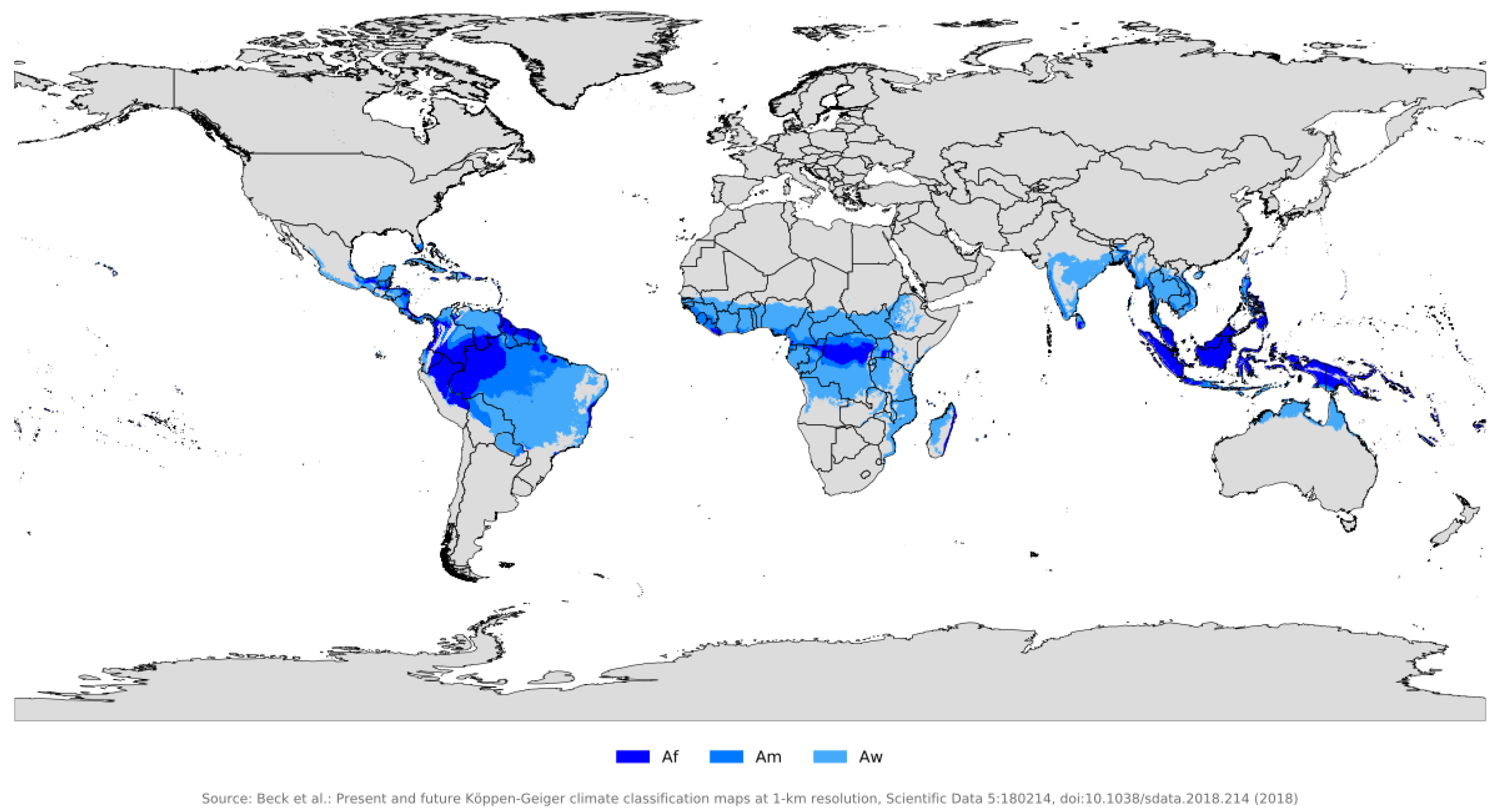
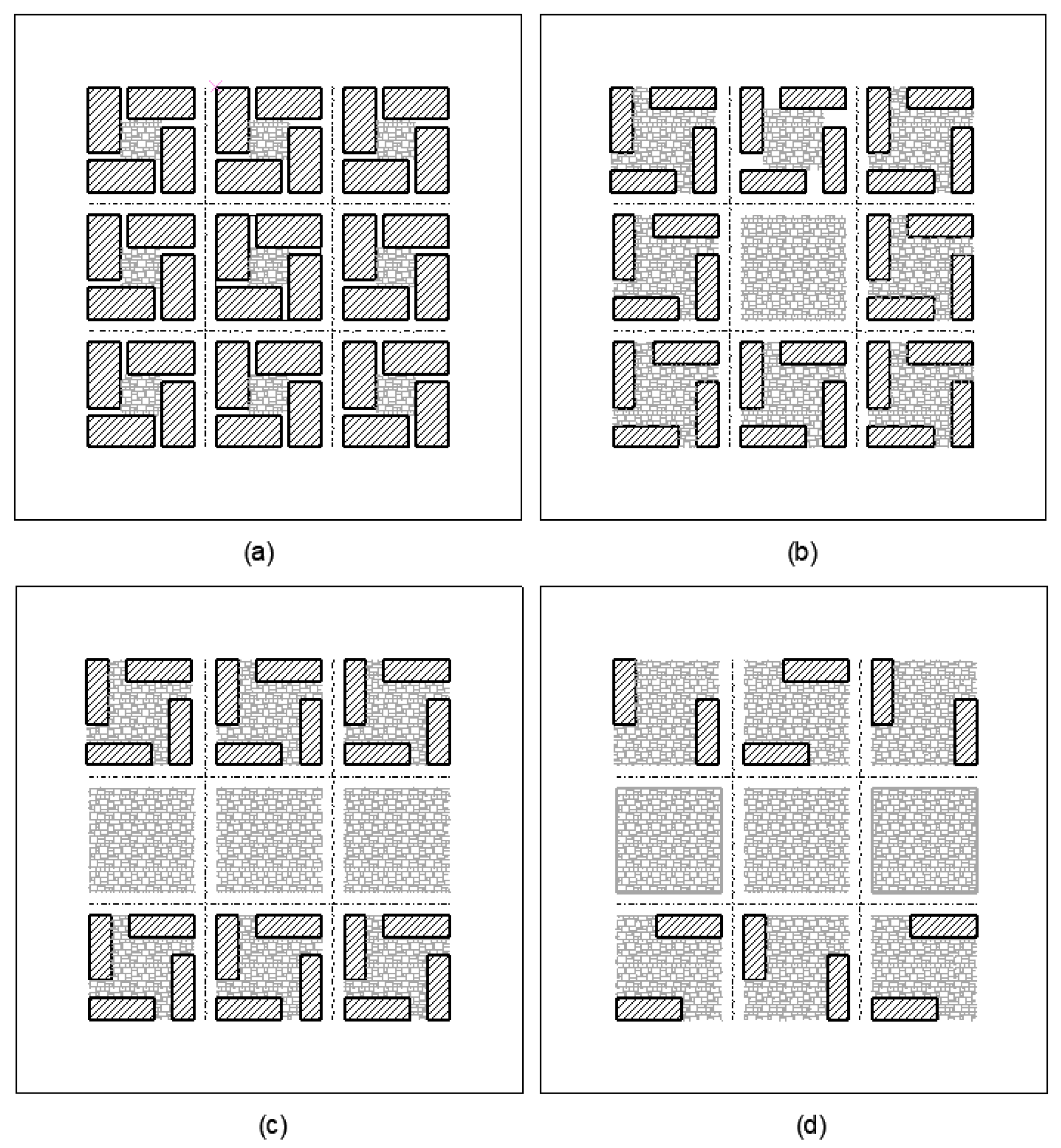
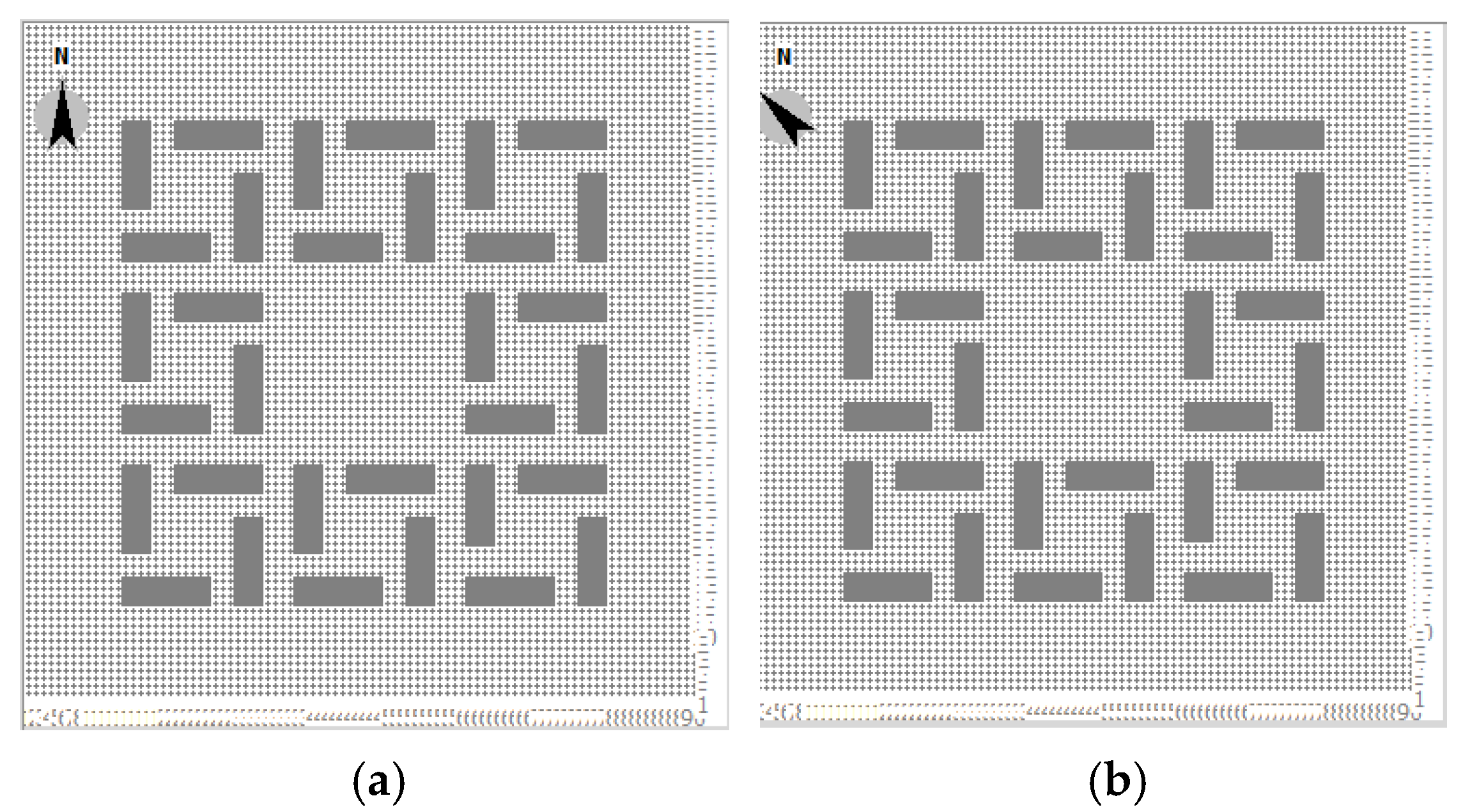
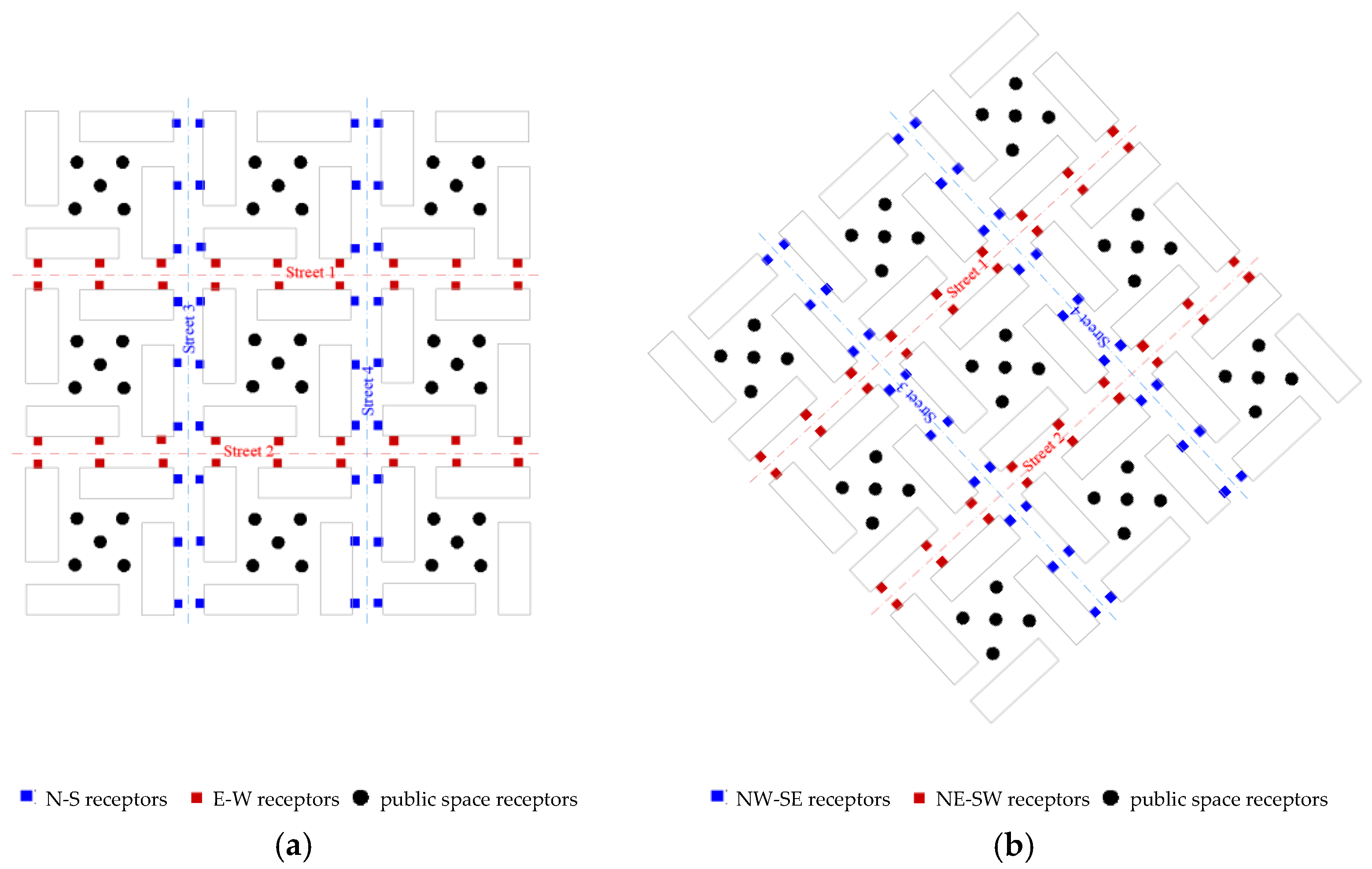
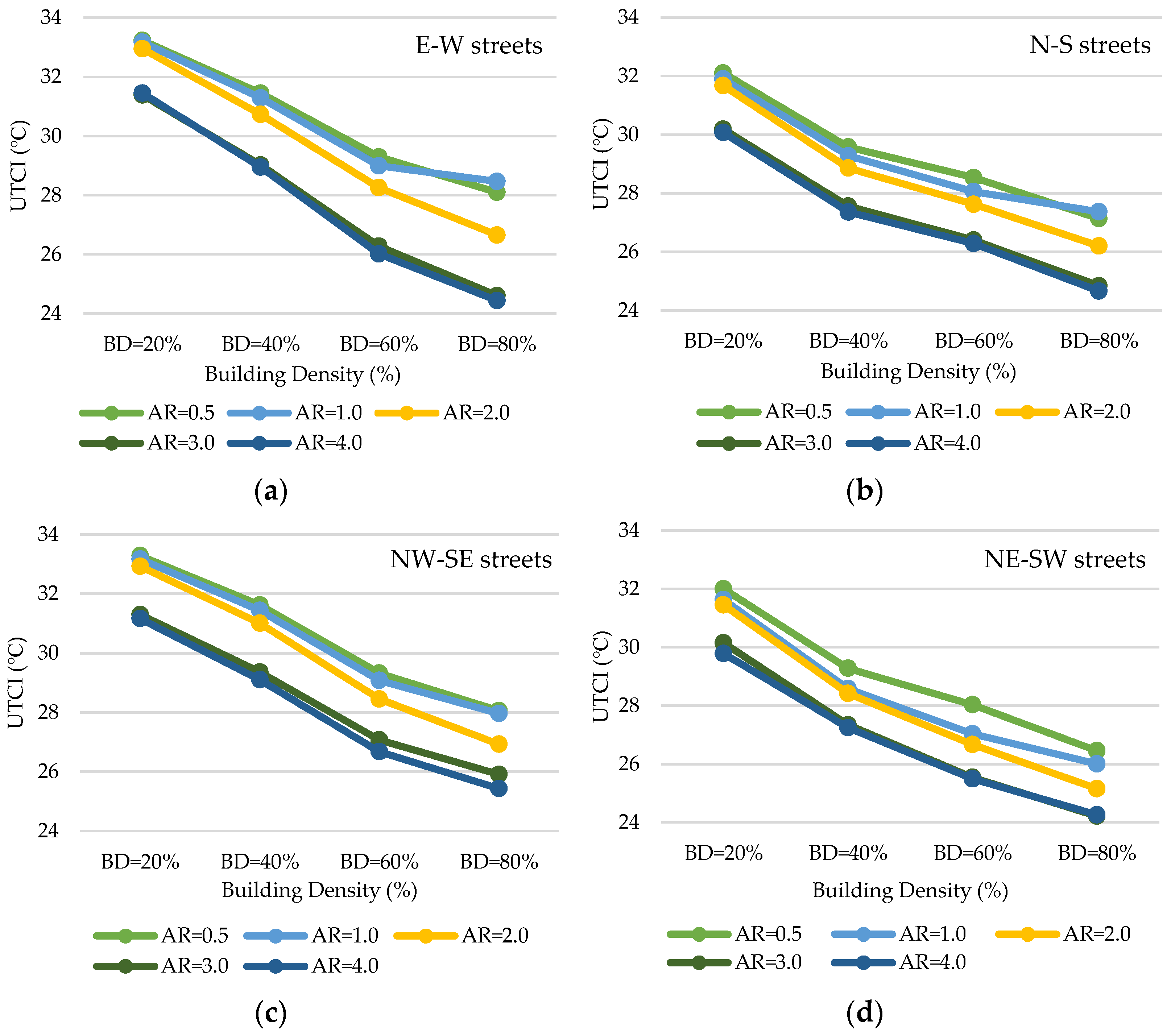
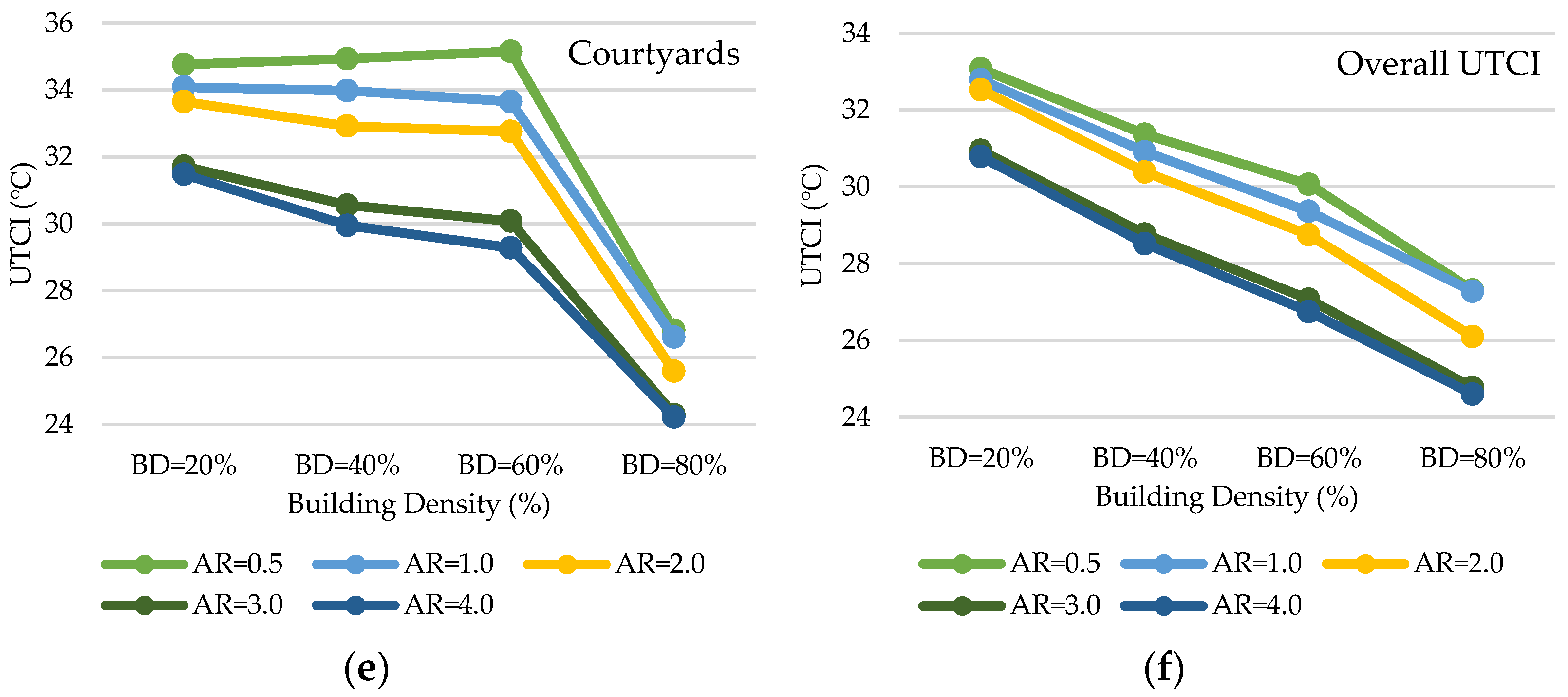
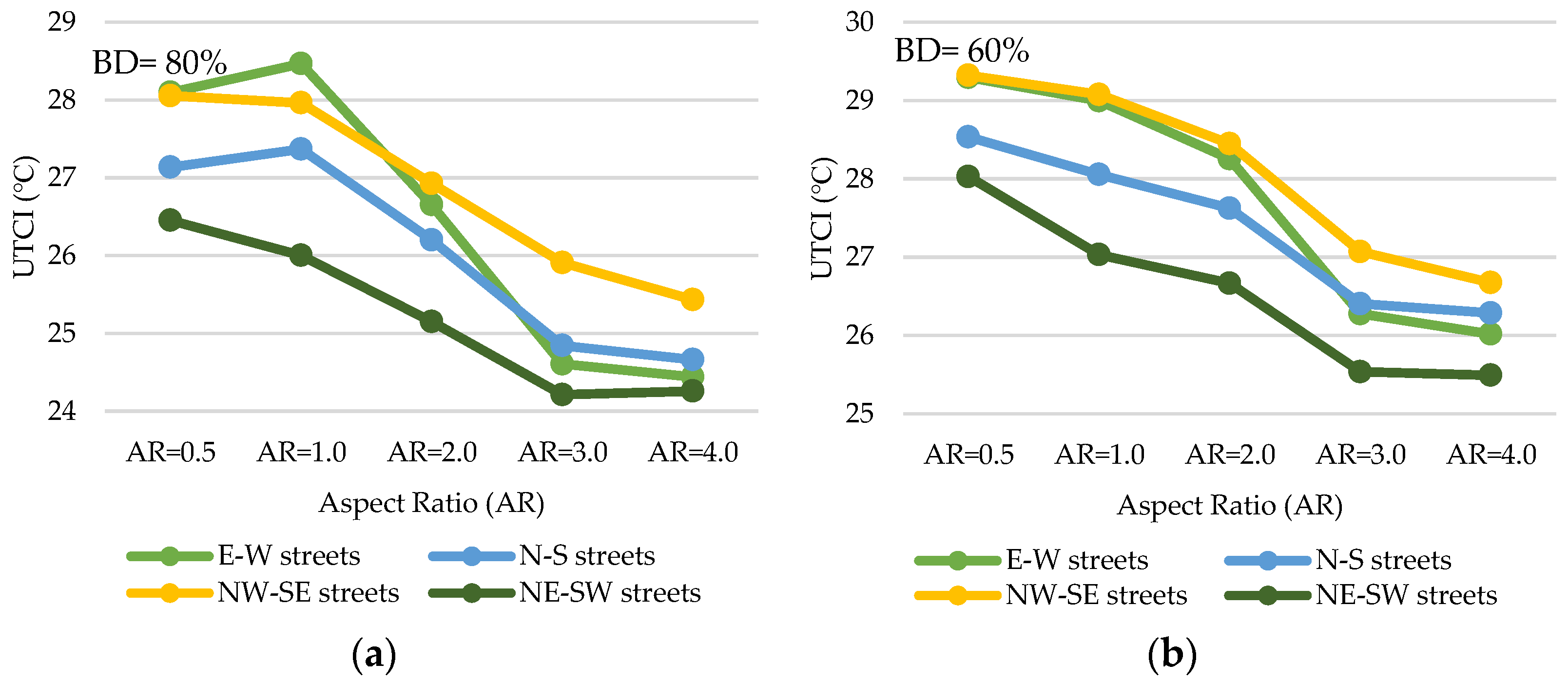
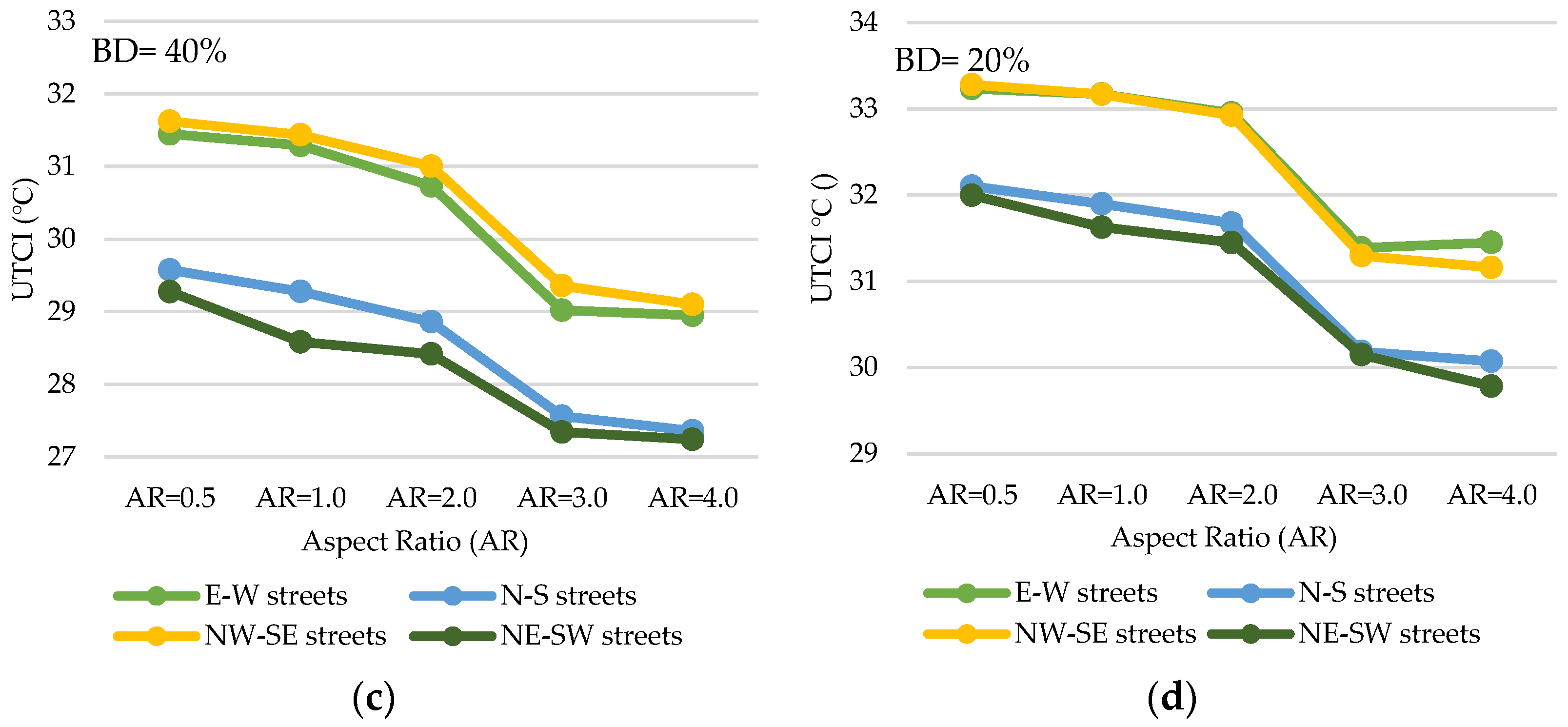

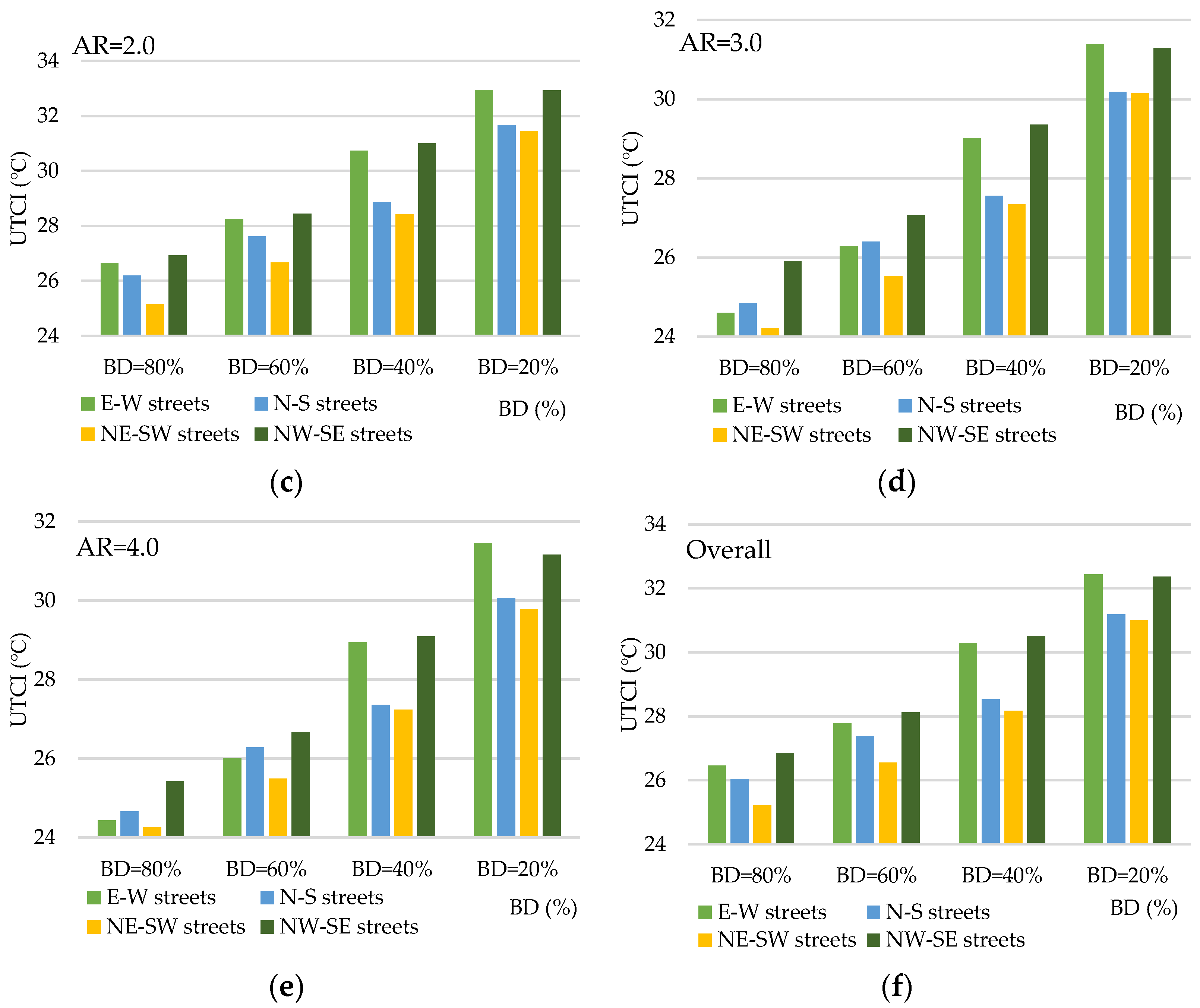
| BDi = 80%; 60%; 40%; 20% | ARi = 0.5; 1.0; 2.0; 3.0; 4.0 | Oi = E–W; N–S; NE–SW; NW–SE | Scenario No. |
|---|---|---|---|
| 80% | 80%/0.5 | 80%/0.5/E–W | UM1 |
| 80%/0.5/N–S | UM2 | ||
| 80%/0.5/NE–SW | UM3 | ||
| 80%/0.5/NW–SE | UM4 | ||
| 80%/1.0 | 80%/1.0/E–W | UM5 | |
| 80%/1.0/N–S | UM6 | ||
| 80%/1.0/NE–SW | UM7 | ||
| 80%/1.0/NW–SE | UM8 | ||
| 80%/2.0 | 80%/2.0/E–W | UM9 | |
| 80%/2.0/N–S | UM10 | ||
| 80%/2.0/NE–SW | UM11 | ||
| 80%/2.0/NW–SE | UM12 | ||
| 80%/3.0 | 80%/3.0/E–W | UM13 | |
| 80%/3.0/N–S | UM14 | ||
| 80%/3.0/NE–SW | UM15 | ||
| 80%/3.0/NW–SE | UM16 | ||
| 80%/4.0 | 80%/4.0/E–W | UM17 | |
| 80%/4.0/N–S | UM18 | ||
| 80%/4.0/NE–SW | UM19 | ||
| 80%/4.0/NW–SE | UM20 | ||
| 60% | 60%/0.5 | 60%/0.5/E–W | UM21 |
| 60%/0.5/N–S | UM22 | ||
| 60%/0.5/NE–SW | UM23 | ||
| 60%/0.5/NW–SE | UM24 | ||
| 60%/1.0 | 60%/1.0/E–W | UM25 | |
| 60%/1.0/N–S | UM26 | ||
| 60%/1.0/NE–SW | UM27 | ||
| 60%/1.0/NW–SE | UM28 | ||
| 60%/2.0 | 60%/2.0/E–W | UM29 | |
| 60%/2.0/N–S | UM30 | ||
| 60%/2.0/NE–SW | UM31 | ||
| 60%/2.0/NW–SE | UM32 | ||
| 60%/3.0 | 60%/3.0/E–W | UM33 | |
| 60%/3.0/N–S | UM34 | ||
| 60%/3.0/NE–SW | UM35 | ||
| 60%/3.0/NW–SE | UM36 | ||
| 60%/4.0 | 60%/4.0/E–W | UM37 | |
| 60%/4.0/N–S | UM38 | ||
| 60%/4.0/NE–SW | UM39 | ||
| 60%/4.0/NW–SE | UM40 | ||
| 40% | 40%/0.5 | 40%/0.5/E–W | UM41 |
| 40%/0.5/N–S | UM42 | ||
| 40%/0.5/NE–SW | UM43 | ||
| 40%/0.5/NW–SE | UM44 | ||
| 40%/1.0 | 40%/1.0/E–W | UM45 | |
| 40%/1.0/N–S | UM46 | ||
| 40%/1.0/NE–SW | UM47 | ||
| 40%/1.0/NW–SE | UM48 | ||
| 40%/2.0 | 40%/2.0/E–W | UM49 | |
| 40%/2.0/N–S | UM50 | ||
| 40%/2.0/NE–SW | UM51 | ||
| 40%/2.0/NW–SE | UM52 | ||
| 40%/3.0 | 40%/3.0/E–W | UM53 | |
| 40%/3.0/N–S | UM54 | ||
| 40%/3.0/NE–SW | UM55 | ||
| 40%/3.0/NW–SE | UM56 | ||
| 40%/4.0 | 40%/4.0/E–W | UM57 | |
| 40%/4.0/N–S | UM58 | ||
| 40%/4.0/NE–SW | UM59 | ||
| 40%/4.0/NW–SE | UM60 | ||
| 20% | 20%/0.5 | 20%/0.5/E–W | UM61 |
| 20%/0.5/N–S | UM62 | ||
| 20%/0.5/NE–SW | UM63 | ||
| 20%/0.5/NW–SE | UM64 | ||
| 20%/1.0 | 20%/1.0/E–W | UM65 | |
| 20%/1.0/N–S | UM66 | ||
| 20%/1.0/NE–SW | UM67 | ||
| 20%/1.0/NW–SE | UM68 | ||
| 20%/2.0 | 20%/2.0/E–W | UM69 | |
| 20%/2.0/N–S | UM70 | ||
| 20%/2.0/NE–SW | UM71 | ||
| 20%/2.0/NW–SE | UM72 | ||
| 20%/3.0 | 20%/3.0/E–W | UM73 | |
| 20%/3.0/N–S | UM74 | ||
| 20%/3.0/NE–SW | UM75 | ||
| 20%/3.0/NW–SE | UM76 | ||
| 20%/4.0 | 20%/4.0/E–W | UM77 | |
| 20%/4.0/N–S | UM78 | ||
| 20%/4.0/NE–SW | UM79 | ||
| 20%/4.0/NW–SE | UM80 |
| Location | Parameters | Model-Validation Criteria | |||
|---|---|---|---|---|---|
| Correlation (R2) | Error | Bias | |||
| Bangkok, Thailand [45] | MRT | 0.91 | - | - | - |
| Cuiaba, Brazil [46] | Air temperature | 0.95 0.98 | 2.39 (RMSE) | 2.00 (MAE) | 1.29 |
| Relative humidity | 0.91 | 14.32 (RMSE) | 14.31 (MAE) | −14.31 (MBE) | |
| 0.90 | 2.72 (RMSE) | 4.21 (MAE) | −2.25 (MBE) | ||
| Akure, Nigeria [47] | Air temperature | 0.96–0.99 | 0.00–0.01 (NMSE) | - | 0.01–0.06 (FB) |
| Relative humidity | 0.82–0.90 | 0.00–0.01 (NMSE) | - | 0.01–0.07 (FB) | |
| Pathanamthitta, Kerala (India) [48] | Air temperature | 0.80–0.92 | 0.58–0.72 (RMSE) | 0.48–0.77 (MAE) | |
| Location | Pathanamthitta, Kerala, India) [48]; Bangkok, Thailand [45] | Cuiaba, Brazil [46,49,50] | Akure, Nigeria [47] |
|---|---|---|---|
| Climate type | Warm–humid tropical (Af) | Hot–humid (Aw2) [50] | Warm–humid (Aw) |
| Simulated summer period | March [48] April [45] | March [50] | September-November |
| Simulation duration | 48 h [48] | 48 h [46] | 72 h |
| Start time | 00:00 [48] 6:00 [45] | 20:00 [46] 7:00 [50] | 6:00 |
| Spatial resolution (grid size) | 2 m × 2 m × 1 m [48] | 2 m × 2 m × 2 m [46] | 2 m × 2 m × 2 m |
| 2.5 m × 2.5 × 2.5 m [50] | |||
| Domain size | 90 × 90 × 25 grids [48] | 180 × 180 × 30 grids [46] 600 m × 600 m [50] | 120 m × 80 m × 60 m |
| Wind speed (m/s) | 1.6 m/s [48] | - | 3 m/s |
| Wind direction (°) | East [48] | 330° (south) [50] | 265° (southwest) |
| Air temperature (°C) | 25.4–38.6 [48] | 24–38 [50] | 25.1–29 |
| Relative humidity (%) | 50–68 [48] | 84 | 90 (shaded)/85 (unshaded) |
| Sky condition | Cloud free (clear) [48] | - | Clear |
| BD = 80% | BD = 60% | BD = 40% | BD = 20% | |
|---|---|---|---|---|
| AR0 | 28.10 | 29.29 | 31.45 | 33.23 |
| AR1 | 28.47 | 29.00 | 31.29 | 33.17 |
| AR2 | 26.65 | 28.26 | 30.73 | 32.95 |
| AR3 | 24.61 | 26.28 | 29.02 | 31.39 |
| AR4 | 24.44 | 26.02 | 28.95 | 31.45 |
| BD = 80% | BD = 60% | BD = 40% | BD = 20% | |
|---|---|---|---|---|
| AR0 | 27.14 | 28.53 | 29.58 | 32.10 |
| AR1 | 27.37 | 28.06 | 29.28 | 31.90 |
| AR2 | 26.20 | 27.62 | 28.86 | 31.67 |
| AR3 | 24.84 | 26.40 | 27.56 | 30.19 |
| AR4 | 24.66 | 26.29 | 27.36 | 30.07 |
| BD = 80% | BD = 60% | BD = 40% | BD = 20% | |
|---|---|---|---|---|
| AR0 | 28.05 | 29.32 | 31.62 | 33.28 |
| AR1 | 27.96 | 29.08 | 31.44 | 33.17 |
| AR2 | 26.93 | 28.45 | 31.00 | 32.92 |
| AR3 | 25.91 | 27.07 | 29.36 | 31.30 |
| AR4 | 25.43 | 26.67 | 29.10 | 31.16 |
| BD = 80% | BD = 60% | BD = 40% | BD = 20% | |
|---|---|---|---|---|
| AR0 | 26.45 | 28.03 | 29.28 | 32.00 |
| AR1 | 26.00 | 27.03 | 28.58 | 31.63 |
| AR2 | 25.15 | 26.67 | 28.42 | 31.45 |
| AR3 | 24.21 | 25.54 | 27.34 | 30.15 |
| AR4 | 24.26 | 25.49 | 27.24 | 29.78 |
| BD = 80% | BD = 60% | BD = 40% | BD = 20% | |
|---|---|---|---|---|
| AR0 | 26.82 | 35.15 | 34.94 | 34.76 |
| AR1 | 26.61 | 33.65 | 33.98 | 34.09 |
| AR2 | 25.59 | 32.76 | 32.92 | 33.65 |
| AR3 | 24.30 | 30.08 | 30.56 | 31.72 |
| AR4 | 24.22 | 29.28 | 29.95 | 31.48 |
Disclaimer/Publisher’s Note: The statements, opinions and data contained in all publications are solely those of the individual author(s) and contributor(s) and not of MDPI and/or the editor(s). MDPI and/or the editor(s) disclaim responsibility for any injury to people or property resulting from any ideas, methods, instructions or products referred to in the content. |
© 2023 by the authors. Licensee MDPI, Basel, Switzerland. This article is an open access article distributed under the terms and conditions of the Creative Commons Attribution (CC BY) license (https://creativecommons.org/licenses/by/4.0/).
Share and Cite
Bedra, K.B.; Zheng, B.; Li, J.; Luo, X. A Parametric-Simulation Method to Study the Interconnections between Urban-Street-Morphology Indicators and Their Effects on Pedestrian Thermal Comfort in Tropical Summer. Sustainability 2023, 15, 8902. https://doi.org/10.3390/su15118902
Bedra KB, Zheng B, Li J, Luo X. A Parametric-Simulation Method to Study the Interconnections between Urban-Street-Morphology Indicators and Their Effects on Pedestrian Thermal Comfort in Tropical Summer. Sustainability. 2023; 15(11):8902. https://doi.org/10.3390/su15118902
Chicago/Turabian StyleBedra, Komi Bernard, Bohong Zheng, Jiayu Li, and Xi Luo. 2023. "A Parametric-Simulation Method to Study the Interconnections between Urban-Street-Morphology Indicators and Their Effects on Pedestrian Thermal Comfort in Tropical Summer" Sustainability 15, no. 11: 8902. https://doi.org/10.3390/su15118902
APA StyleBedra, K. B., Zheng, B., Li, J., & Luo, X. (2023). A Parametric-Simulation Method to Study the Interconnections between Urban-Street-Morphology Indicators and Their Effects on Pedestrian Thermal Comfort in Tropical Summer. Sustainability, 15(11), 8902. https://doi.org/10.3390/su15118902







